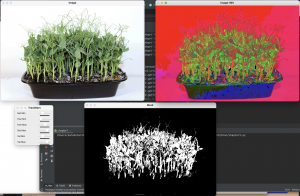This week, my team members and I researched and designed the components of the projects individually assigned to us. In particular, I looked into several tutorials and found built in functions in the OpenCV module that would help with differentiating the plant from the rest of the video for CV analysis to be done. In speciic, I looked into the pixel per metric technique to figure out the real life size of objects through the camera, HSV color detection and edge detection to detect withering, disease, bending, and flowers/ fruits. Using a pea shoot image I found online, I found certain color hue, saturation, and value that would separate the bundle of pea shoots from the rest of the objects in the captured image such as the soil, the background, and the planting tray. Afterwards, I implemented some edge detection to get a clear outline of the shapes of the stems and leaves. My teammates and I also ordered our materials on Monday, and I have received all the hardware I need such as the RPi, RPi power adapter, RF transmitters and receivers, and planting material.
My progress is on schedule, as my team just needs to make some final adjustments on the design review presentations after receiving feedback, and we are all started on the implementation process of each of our tasks. I learned a lot more about OpenCV this week and have a much clearer idea of how I can use the built in functions to cater to image and video analysis of plants.
By next week, I hope to connect my camera to my RPi, and work with the RPi camera for my CV application. I would like to figure out the HSV parameters out of the images that the camera provides and I will most likely use some plants I have at home to figure out the basics to HSV Color and Edge detection specific the camera and lighting at my place. I would like to accomplish the pixel by metric technique and the flower distinguishing algorithm by the end of next week.


